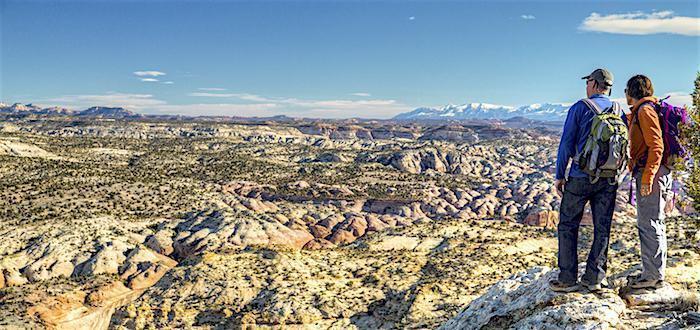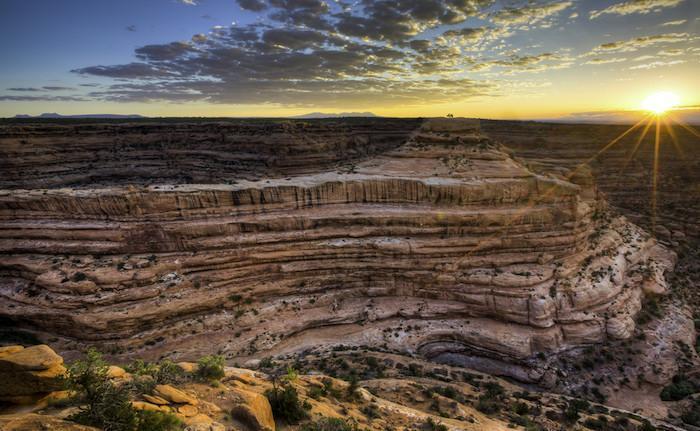
Draft management plans could lead to energy development on the doorstep of Grand Staircase-Escalante National Monument/BLM
Proposed management plans for two national monuments in southern Utah that were reduced in size by President Trump and their surrounding lands would increase air quality impacts, pose a greater threat than other alternatives to cultural resources, and not manage any acres to protect wilderness qualities while make more lands available to mining and livestock grazing.
Although there are pending lawsuits that challenge the legitimacy of the president's proclamations made in December 2017 on the steps of Utah's Capitol, the U.S. Bureau of Land Management is moving forward to develop management plans that could allow mining within the original boundaries of the monuments. At a time when one of counties that pushed for shrinkage of Bears Ears National Monument now is branding its tourism campaign with the tag line, "Make It Monumental," the preferred alternatives for Bears Ears and Grand Staircase-Escalante National Monument would weaken protections that often go hand-in-hand with tourism.
As the Washington Post noted last December, the areas Trump cut out of the two monuments in 2017 “contain large deposits of coal, uranium, oil and gas.”
While Interior Secretary Ryan Zinke has said the redrawing of the boundary lines of the two monuments had nothing to do with energy development, one of the documents released Wednesday by the U.S. Bureau of Land Management said some areas of the Kaiparowits Plateau now outside the boundaries of the original Grand Staircase-Escalante National Monument contain sizeable coal reserves that "are rated high for development potential."
The minerals report, prepared for the BLM by the state of Utah, was less encouraging for oil and gas development, saying the remoteness of the area, lack of infrastructure, and depressed energy prices made it unlikely for this type of exploration.
Still, the analysis of possible impacts said that energy development permitted under the preferred management alternative for the lands removed from the Grand Staircase-Escalante monument "has the potential to produce a perceptible plume in contrast with the sky and terrain in Bryce Canyon National Park. This could occur as a result of the overlap between oil and gas completion activities and days of adverse meteorological conditions."
However, the report added that those impacts "would be a rare occurrence."
“It’s been nearly 20 years since the public has had the unique opportunity to help shape the future of the Grand Staircase-Escalante National Monument—the BLM’s first ever national monument,” said BLM Utah State Director Ed Roberson. “Developing new management plans is an exciting challenge and a serious responsibility that is shared by everyone who cares about these lands.”
With a public comment period on the plans for Bears Ears and Grand Staircase-Escalante national monuments expected to open Friday and run for 90 days, through November 15, the documents are expected to generate great pushback from conservation and environmental groups and some Native American tribes that opposed the president's act to greatly shrink the two monuments. Some groups spoke out Wednesday.
“After this administration illegally rolled back protections on the largest acreage of public land in U.S. history, moving forward with business-as-usual is a charade," said Western Values Project Executive Director Chris Saeger. "The Bureau of Land Management should not be proceeding with the Resource Management Plans for Bears Ears and Grand Staircase Escalante National Monuments.
"We know that both these monument reductions were made at the behest of the same special interests and extractive corporations that brought the Trump administration into office," he added. "The administration should wait for legal challenges to the reductions to have their day in court before Secretary Zinke tries to open up stolen land to corporate land barons and sell off our protected lands to the highest bidder.”

The preferred alternatives in the draft management plans would weaken protections for air quality, cultural resources, and paleontological resources, among other things/BLM
Republican politicians in Utah, from the local level to the Statehouse and up to the congressional delegation, long sought ways to shrink the Grand Staircase-Escalante almost from the September day back in 1996 when President Clinton designated it. Driving much of their determination were the known coal reserves on the Kaiparowits Plateau, which covers about 1,650 square miles in southern Utah and touches not only the Grand Staircase-Escalante but also Glen Canyon National Recreation Area and Bryce Canyon National Park. A study by the U.S. Geological Survey estimated that about 28 billion tons of recoverable coal lies within the plateau.
Andelex Resources envisioned mining that coal for 40 years until Grand Staircase-Escalante was designated by President Clinton; that project was then banned and the company's interests bought out by the Interior Department for $14 million.
By declaring new boundaries for Grand Staircase-Escalante and Bears Ears national monuments, a move that sheds 2 million acres combined from the two, President Trump has claimed he was acting to preserve "states rights." At the same time, his action could also allow those 2 million acres of federal lands to be opened to energy development and other uses monument status had banned.
"Some people think that the natural resources of Utah should be controlled by a small handful of very distant bureaucrats located in Washington," President Trump said in December 2017 during an appearance on the Utah Capitol's steps with Utah politicians and Secretary Zinke. "And guess what: They're wrong."
When President Trump used that appearance to announce he was redrawing the monuments' boundaries, he maintained that Presidents Clinton and Barack Obama, who established Bears Ears in December 2016, "severely abused the purpose, spirit, and intent of a century-old law known as the Antiquities Act." His proclamations cut the 1.9-million-acre Grand Staircase-Escalante National Monument by a bit more than 1 million acres and broke it into three monuments to be known as Grand Staircase, Escalante Canyons, and Kaiparowits. Bears Ears National Monument would be shrunk to a bit more than 201,000 acres from its original size of 1.3 million acres if his actions withstand legal scrutiny.
But conservationists have pointed to survey after survey that show strong support across the nation and in Utah, specifically, for these two monuments as well as others. Groups ranging from tribal organizations to corporations that dwell in the outdoor recreation market and non-governmental organizations that work to safeguard the federal realm of public lands, from national monuments to national parks, promised to challenge the legality of President Trump's actions.
Indeed, within hours of the president's announcement a lawsuit was filed in Washington, D.C., in behalf of eight plaintiffs: The Wilderness Society, the Grand Canyon Trust, the Sierra Club, Defenders of Wildlife, Great Old Broads for Wilderness, Center for Biological Diversity, WildEarth Guardians and Western Watersheds Project. The Southern Utah Wilderness Alliance and Natural Resources Defense Council are co-plaintiffs in the lawsuit and represented by in-house counsel. It argues that while presidents can use The Antiquities Act to designate national monuments, they can not alter them; only Congress has that authority.
Also speaking out Wednesday against the BLM management proposals was Ashley Soltysiak, director of Utah Sierra Club .
“Secretary Zinke’s motivation has clearly been to exploit our public lands to benefit the dirty fuel industry all along, regardless of the cultural, natural and economic costs," she said. "The Trump administration acted illegally when it stripped the lands of Bears Ears and Grand Staircase-Escalante of monument status. Now the Interior is rushing to let in mining and drilling before a court can overturn the rollbacks.
“Utah’s wild places are deeply connected with the people and identity of this region. We will continue to challenge attempts to open these lands for outdated and dirty fuel development at every opportunity.”
At the National Parks Conservation Association, President and CEO Theresa Pierno said the administration should wait until legal challenges to the president's redrawing of the monuments are heard before moving ahead with new management plans.
"Until the courts determine where Bears Ears and Grand Staircase land protections stand, planning and managing for the sites in question are a waste of taxpayer resources and should be a nonstarter," she said.
“The management plans proposed leave the surrounding national park landscapes - Glen Canyon National Recreation Area, Capitol Reef and Bryce Canyon – vulnerable to destructive development. Through these proposed plans, the administration is choosing the most damaging options of the alternatives presented, proposing a direction that will knowingly harm Bryce, Capitol Reef and Glen Canyon through damaging off-road vehicle use, spreading of invasive species and mineral development. At Canyonlands, we are most concerned about potential damaging off-road vehicle use. Paving the way for destructive development like this will extend to the doorsteps of surrounding national parks, all at the expense of our nation’s most culturally significant places."



Comments
The plot thickens. First the Washington Post and SL Tribune each reported Thusday in their coverage of these BLM proposed management plans that they include selling off a bunch of modest sized parcels adding up to 1600 acres to adproperty owners, including a small parcel adjacent to land owned by Mike Noel, R Utah State Legislator and big Trump supporter. BLM claimed it was required by law to identify federal property suitable for disposal in its land-use planning. The law allows the Secretary of Interior to sell those lands with competitive bidding or without competitive bidding.
https://www.washingtonpost.com/energy-environment/2018/08/16/zinke-said-...
https://www.sltrib.com/news/environment/2018/08/15/feds-release-management/
Then today the news is that Zinke didn't know about what his BLM was doing, was furious when he heard about it, and has cancelled all sales. Does that mean it wasn't actually required by law, or simply that the law doesn't need to be followed?
https://www.sltrib.com/news/politics/2018/08/17/interior-secretary/
https://www.huffingtonpost.com/entry/trump-administration-utah-monument-...